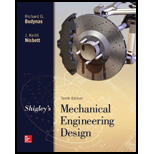
Concept explainers
2-21 to 2-23 A 1-in-diameter rod. 3 ft long, of unknown material is found in a machine shop. A variety of inexpensive nondestructive tests are readily available to help determine the material, as described below:
- (a) Visual inspection.
- (b) Scratch test: Scratch the surface with a file; observe color of underlying material and depth of scratch.
- (c) Check if it is attracted to a magnet.
- (d) Measure weight (±0.05 Ibf).
- (e) Inexpensive bending deflection test: Clamp one end in a vise, leaving 24 in cantilevered. Apply a force of 100 Ibf (±1 lbf). Measure deflection of the free end (within ± 1/32 in).
- (f) Brinell hardness test.
Choose which tests you would actually perform, and in what sequence, to minimize time and cost, but to determine the material with a reasonable level of confidence. The table below provides results that would be available to you if you choose to perform a given lest. Explain your process, and include any calculations. You may assume the material is one listed in Table A-5. If it is carbon steel, try to determine an approximate specification from Table A-20.
| Test | Results if test were made | ||
| Prob. 2-21 | Prob. 2-22 | Prob. 2-23 | |
| (a) | Dark gray, rough surface finish, moderate scale | Silvery gray, smooth surface finish, slightly tarnished | Reddish-brown, tarnished, smooth surface finish |
| (b) | Metallic gray, moderate scratch | Silvery gray, deep scratch | Shiny brassy color, deep scratch |
| (c) | Magnetic | Not magnetic | Not magnetic |
| (d) | W = 7.95 Ibf | W = 2.90 Ibf | W = 9.00 Ibf |
| (e) | δ = 5/16 in | δ = 7/8 in | δ = 17/32 in |
| (f) | HB = 200 | HB = 95 | HB = 70 |
Want to see the full answer?
Check out a sample textbook solution
Chapter 2 Solutions
Shigley's Mechanical Engineering Design (McGraw-Hill Series in Mechanical Engineering)
- If we want to measure the stress of a flat non-uniform component, what should we pay attention to before the measurement?arrow_forwardNote: Kindly give me both right answers. A) Did the ductile materials (annealed and aluminium) react differently to the two different testing methods (hardness test vs. tensile test)? What does this say about the behaviour of ductile materials in compression vs. tension? B) Did the brittle material (quenched) react differently to the two different testing methods (hardness test vs. tensile test)? What does this say about the behaviour of brittle materials in compression vs. tension? (Three to five sentence answers are good)(engineering material)arrow_forward1. What are the elastic modulus (E) and the Poisson's ratio () used to indicate? 2. Illustrate the differences between actual stress and engineered stress with strain, and also describe their underlying physical concepts. 3. If the engineering strain is 2% for a specific state of uniaxial stress, what is the real strain? Please solve for all in full detail and step by steparrow_forward
- Two standard samples of two different minerals were tested using the Sharpy effect device, so that the pendulum rose to a height (40) when testing the first sample and to a height of 60 cm when testing the second sample.Which two metals are more durable have this been explained scientificallyarrow_forward1. Sketch stress-strain curves for the following three materials (mechanically worked tungsten metal, annealed tungsten metal, and tungsten carbide) on the same plot. On each curve, label the following: ultimate compressive strength (UCS), yield stress (YS), modulus of elasticity (E), and rupture stress (RS).arrow_forwardThe bulk modulus of a material, as a meaningful physical property, is applicable to which of the following? Choose A. Only liquid B. Only gas C. Solids, liquids and gases D. Only solidarrow_forward
- Define the given terms related to mechanical properties of materials. 1. elastic material 2. Apparent Viscosity 3. Bend test 4. Bingham Plastic 5. Dilatantarrow_forwardIn a tensile test for an aluminum alloy, the sample is 2 inches long and 0.5 inches in diameter. The proportional portion of the tension stress-strain diagram for an aluminum alloy is shown below. Now that the axial stress of the sample under a tensile load of 9 kips is below material's proportional limit, please calculate the elongation of the sample under the tensile load of 9 kips: ____ inch. Pay attention to units and calculate your answer to 4 decimal place.arrow_forwardinformation: "When performing a tensile test of a metal, these values were found for stress and strain. the yield strength (YS) is stress at 0.2% plastic strain" The task: A 5 meter long rod of this material is loaded axially with a stress of 244 MPa.i. How long is the rod under load?ii. Then the bar is relieved, how long is it now?arrow_forward
- the behaviour of sponge material under stressarrow_forwardWatch the Torsion Test Demonstration of Cast Iron and Carbon Steel through the following link: https://www.youtube.com/watch?v=qPIug2sewFA In 10 sentences, compare and contrast the results of the test between the cast-iron and the carbon steel.arrow_forwardYou are a comparative evolutionary biologist that studies biomechanics. In particular, you are interested in how bone cross sectional shapes have evolved. You have discovered a rare (hypothetical) animal that has bone shapes similar to ours, but has solid, rectangular cross sectional areas. You conduct mechanical testing according to the parameters below and want to determine the: (A) moment of inertia; (B) reaction forces and moments at the fixed end O; (C) the stresses at points A, B, and C designated below, including the contributions of the different types of stresses at each pointarrow_forward
 Welding: Principles and Applications (MindTap Cou...Mechanical EngineeringISBN:9781305494695Author:Larry JeffusPublisher:Cengage Learning
Welding: Principles and Applications (MindTap Cou...Mechanical EngineeringISBN:9781305494695Author:Larry JeffusPublisher:Cengage Learning
